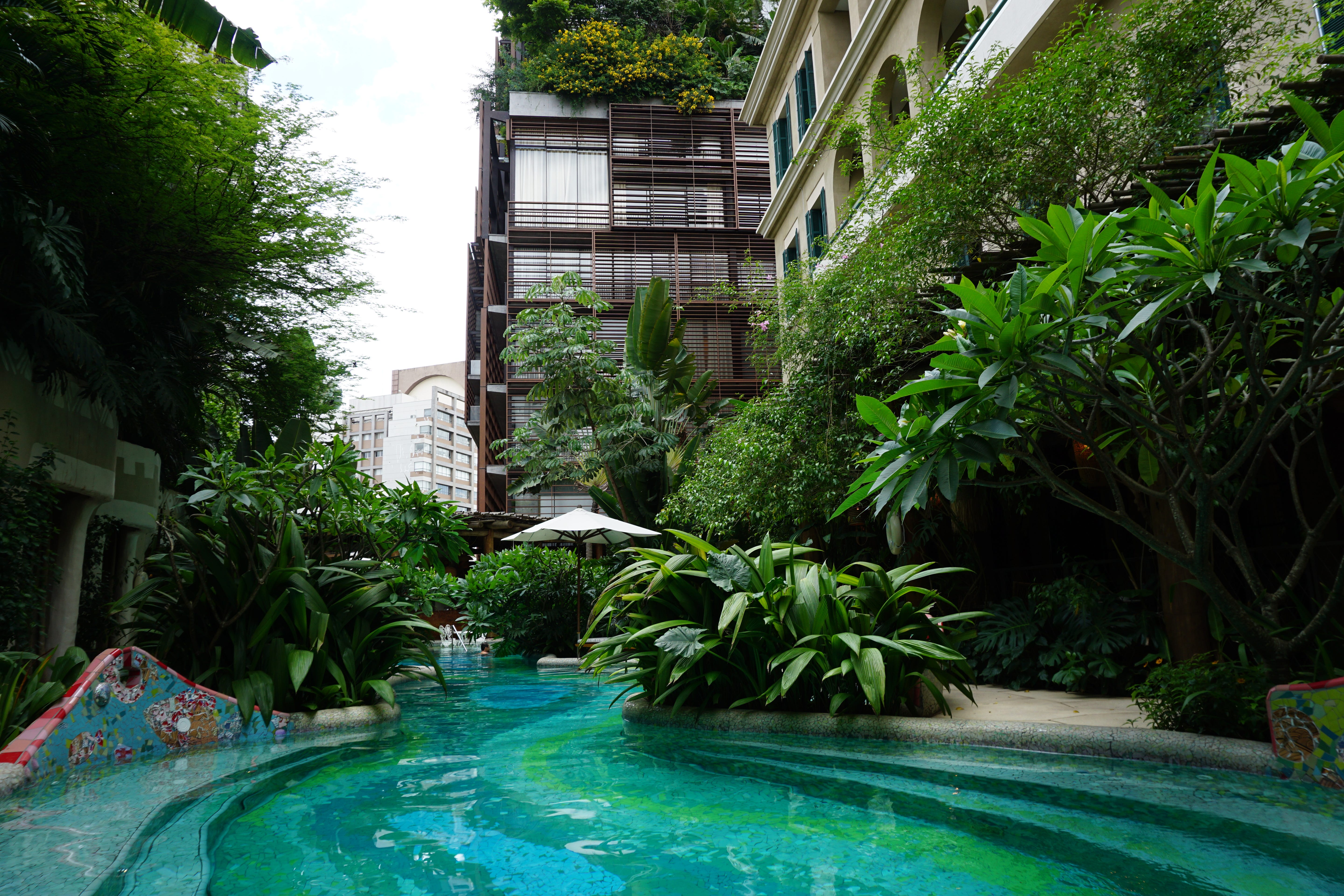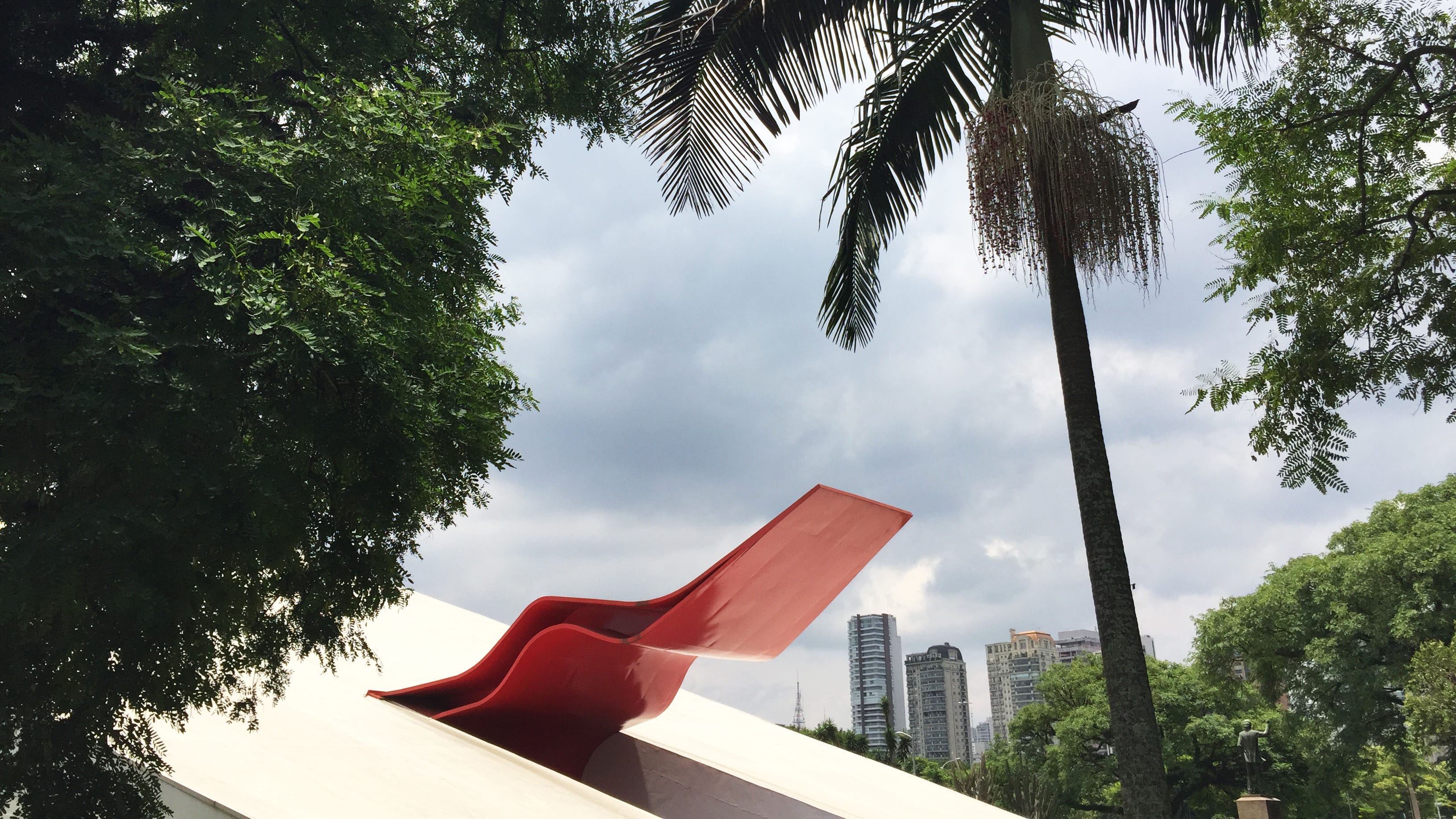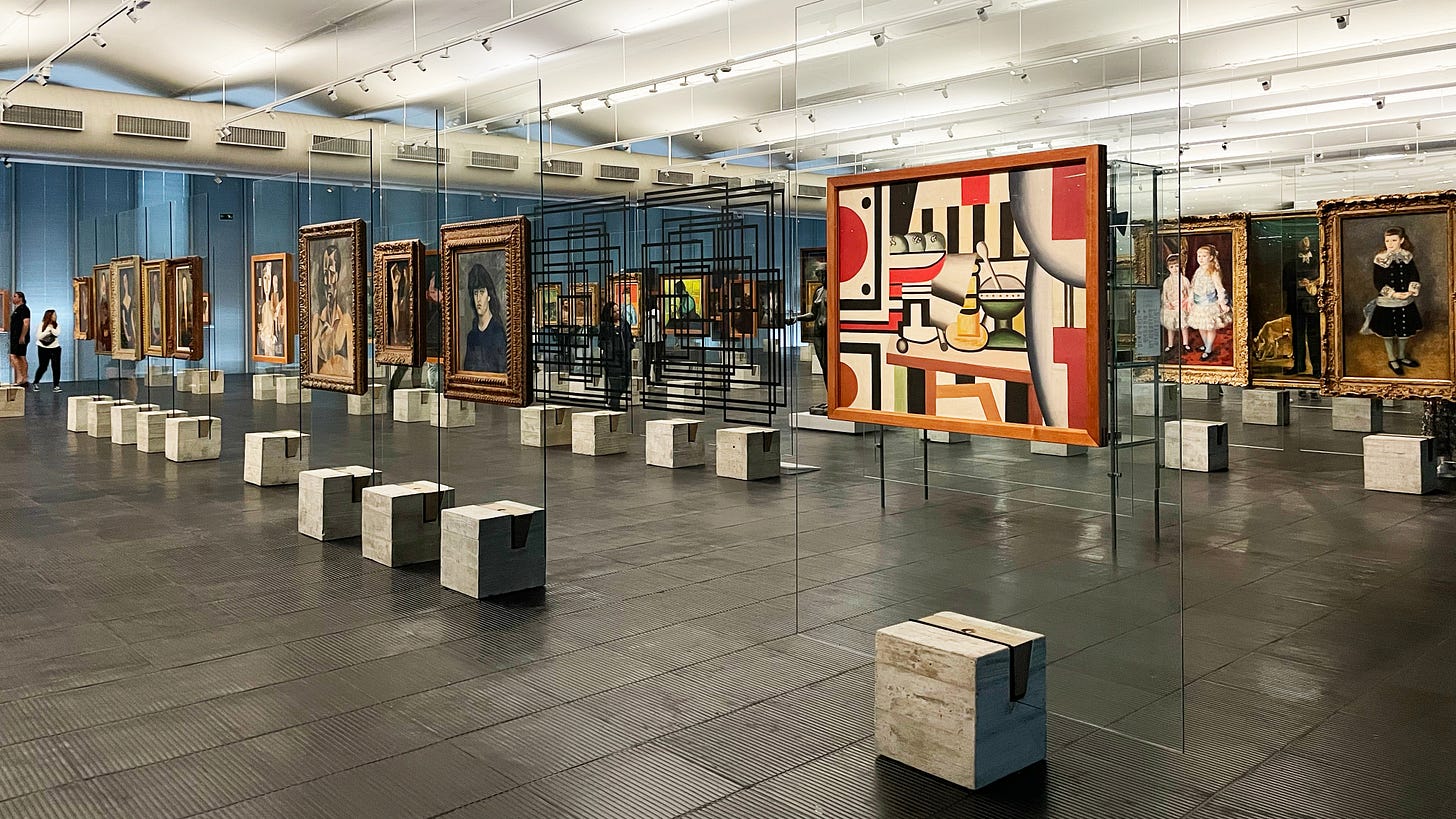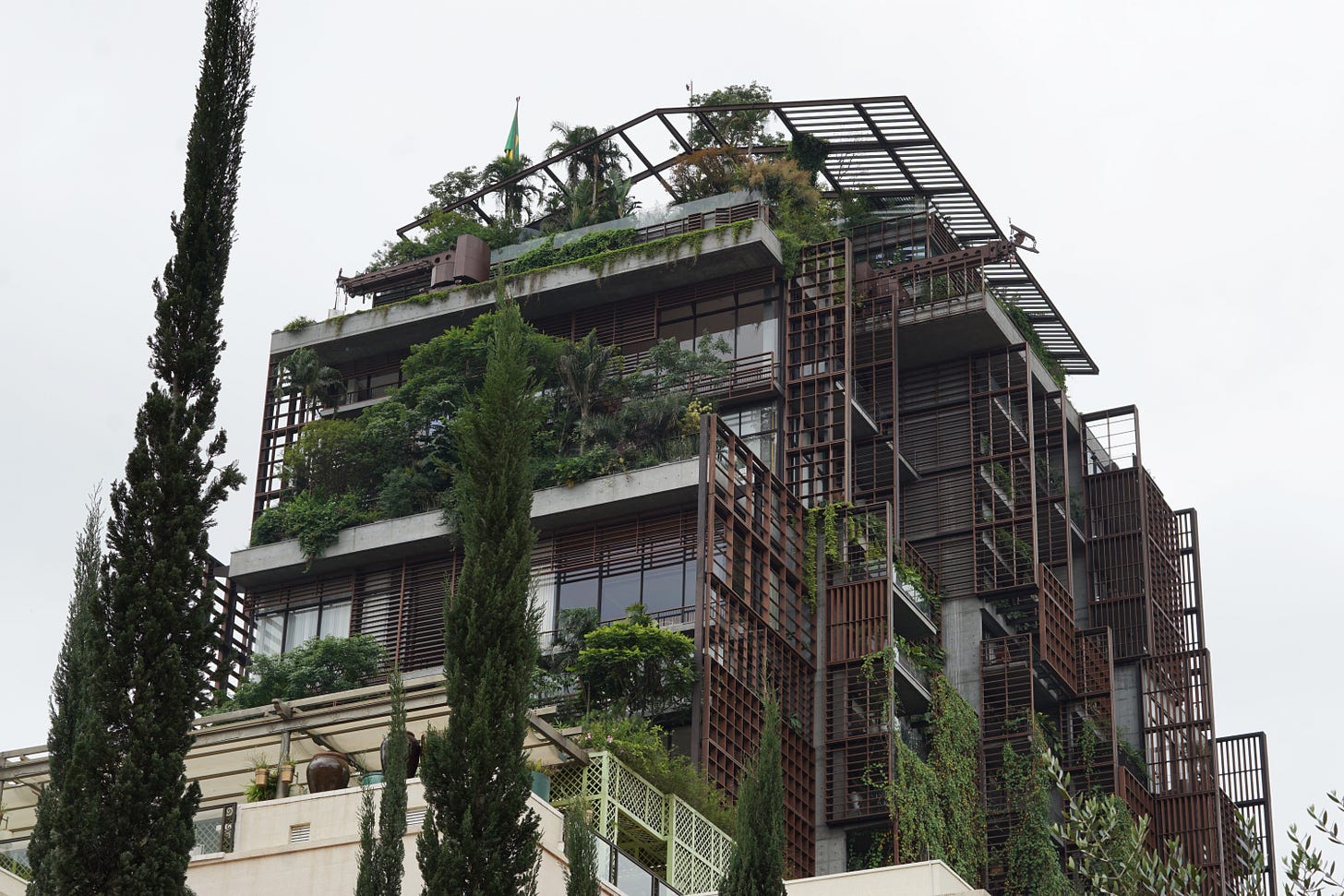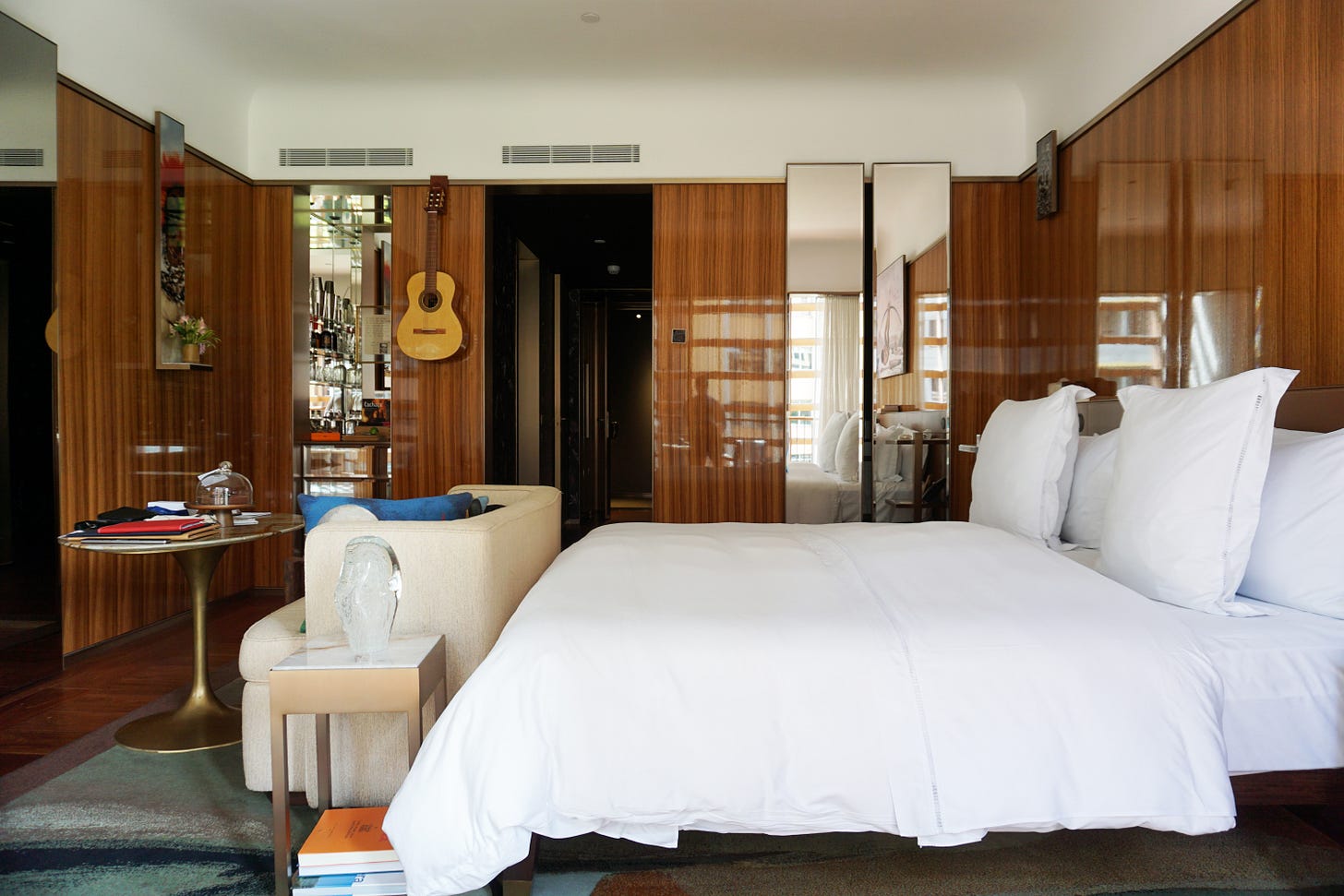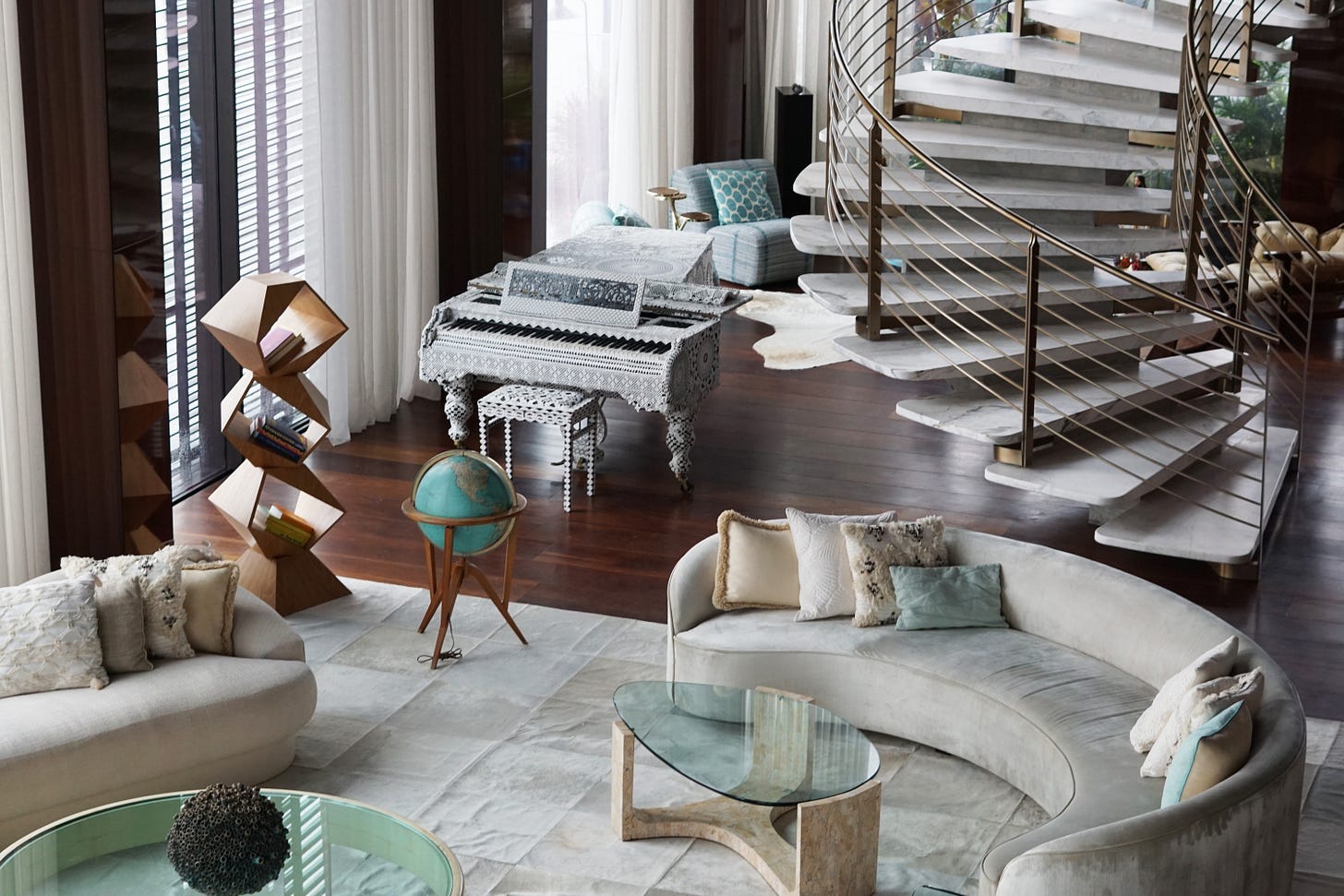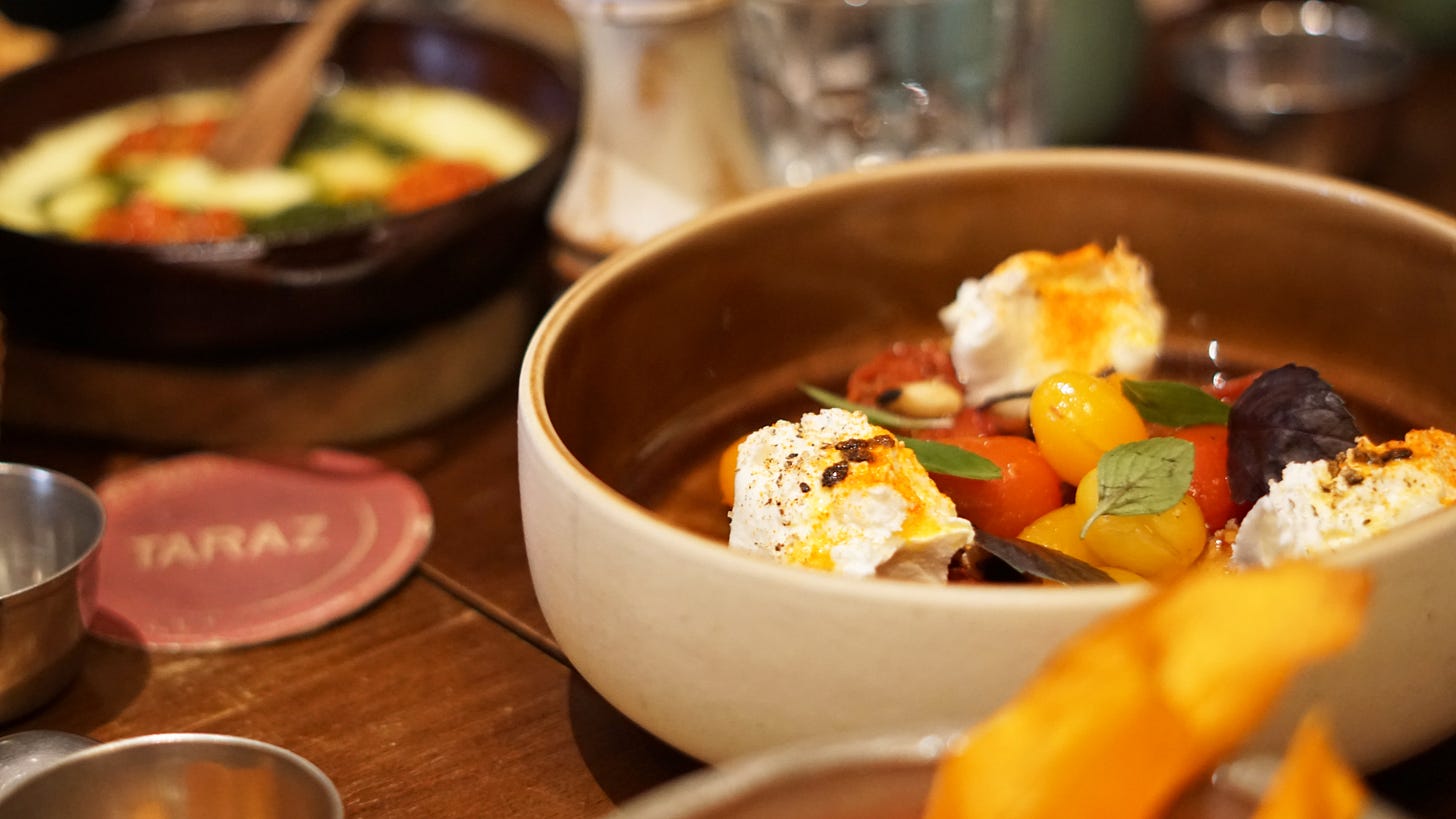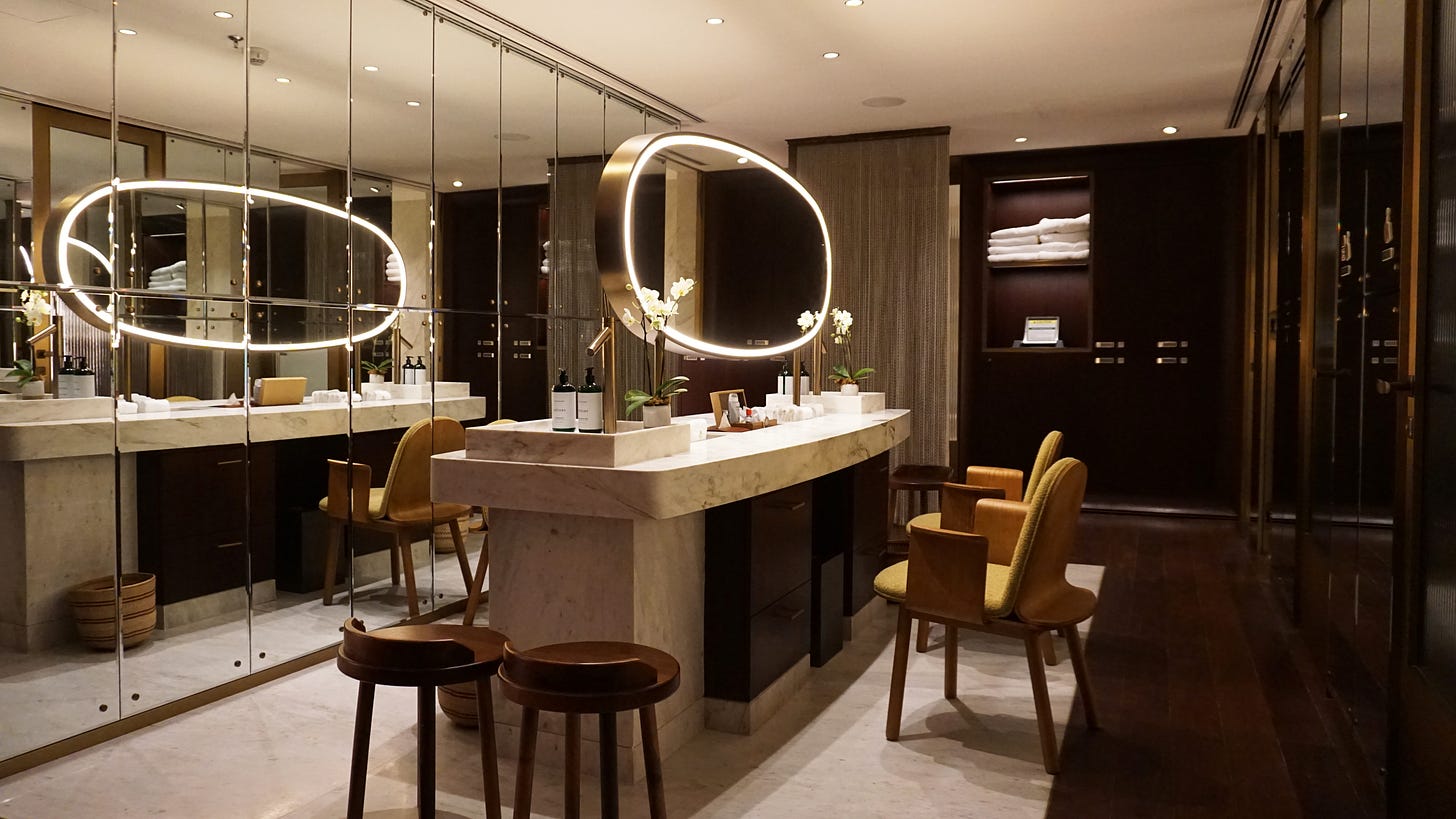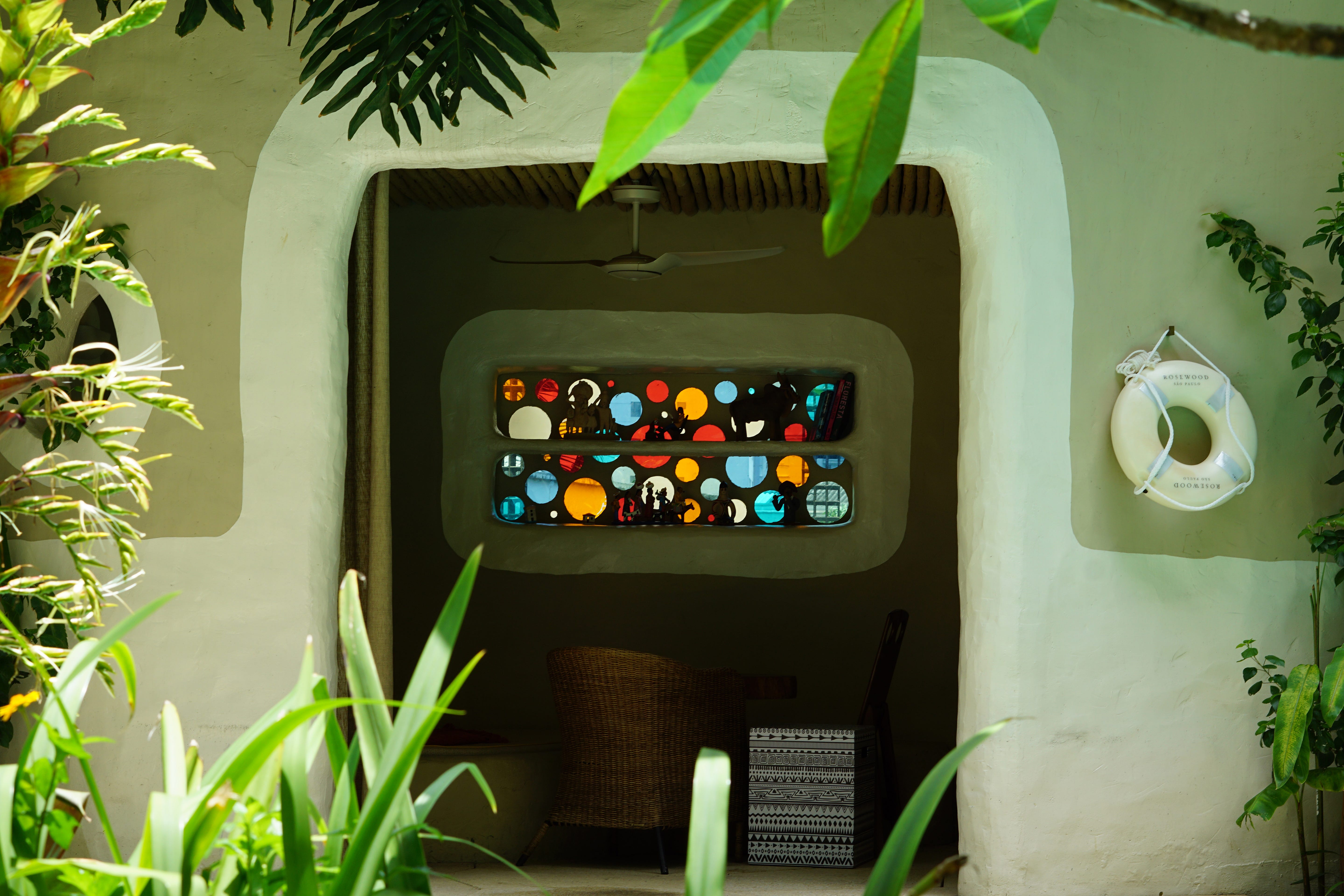South America's Best Hotel
Issue 005: Over 450 site-specific works by Brazilian artists are the jewels in the Rosewood São Paulo's newly minted crown.
Introduction
*Sighs heavily* So, I departed for São Paulo less than 24 hours after Trump’s 2024 US Presidential Election victory was declared. Needless to say, I was ready to GTFO of America—even if only for four days. It could’ve been anywhere, I wouldn’t have cared. But Brazil turned out to be the perfect (albeit temporary) distraction. The nine-hour red-eye flight from NYC offered enough time to mentally reset (and cry a little), before being plunged into the chaos of a city where one needs to keep their wits about them. Crime and traffic accident rates are both high here, however it’s a much safer place than it once was.
The last time I was in São Paulo was in 2015 for the What Design Can Do conference. I didn’t really get to experience much of the city aside from a quick visit to Parque Ibirapuera, where several sculptural concrete pavilions designed by Oscar Niemeyer—Brazil’s most celebrated architect—are situated amongst the lush greenery. Almost a decade later, I joined a small press trip that offered slightly more opportunity to explore, but we were still relatively confined to the centrally located Cidade Matarazzo for the majority of our time.
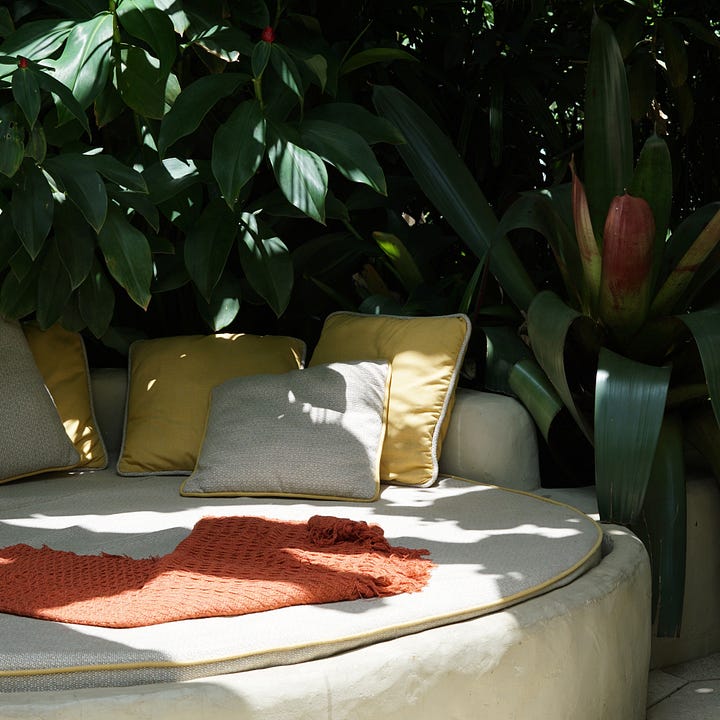
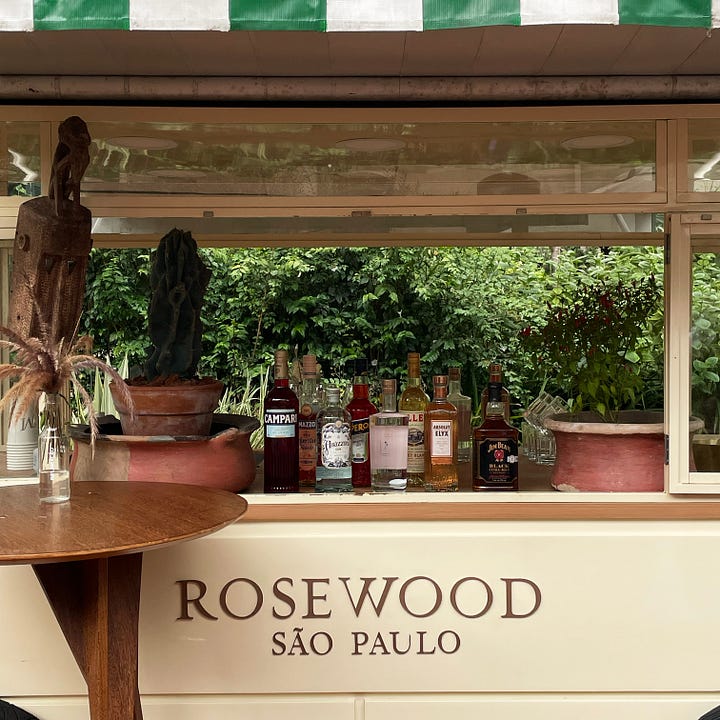
The complex of historic buildings that was once a hospital is gradually being transformed into a major cultural and retail hub, at one end of which is the first Soho House in South America, and at the other is the Rosewood São Paulo hotel I had come to check out. The urban resort opened its doors in 2022, and last year made it onto The World’s 50 Best Hotels list at spot #24—the highest ranking in South America. So naturally, I was curious to see what all the fuss is about.
It rained heavily non-stop for the first two days of the trip, and the weather was cool and overcast on the third (the locals all commented that it was unseasonably chilly for November), but the sun finally made an appearance on the final day. The gloom made me feel less guilty about spending time inside the hotel and visiting the museums on our itinerary, and there’s something about a tropical storm that I really love, so I wasn’t too bothered. There’ll be other opportunities to top-up my winter tan.
São Paulo
São Paulo is a city of almost 12 million people, and it feels like it. The density and sprawl of its nondescript concrete towers, the miles of traffic, and the bustle of its sidewalks all contribute to an intense experience—particularly for first-timers. This is Brazil’s commercial and cultural heart, responsible for one third of the country’s GDP, and home to 100s of museums, art galleries, and institutions. Paulistanos, as the locals are known, are not shy about bragging about their city’s financial and civic wealth either.
Located in the south of the country, the climate is tropical so the summer season from October to March is typically hot and humid. The city center is a couple of hour’s drive from the coast and beaches, which urbanites escape to on the weekends (unless they take the hour-long flight to Rio de Janeiro, as many do). The Pinheiros and Tietê rivers cut through the steep hilly topography across which the metropolis spreads undeterred, and its neighborhoods are defined by the huge highways that bisect the packed clusters of skyscrapers.
With a relative lack of well-known distinctive or historic architectural sites, natural wonders, or charming walkable neighborhoods, São Paulo is not on many people’s bucket list. But its creative pulse and cosmopolitan flair make it a unique destination worth more than just a business trip or a layover. You just need to know where to look.
Arts & Culture
Of the aforementioned cultural institutions, a few stand out as “must-sees” for art and design aficionados. The first is Pinacoteca, which focuses on Brazilian works ranging from the 19th century to today, and is housed in a 100-year-old building on the edge of Parque Jardim da Luz. The collection is unusually organized by theme, displaying works from different eras side by side for comparison and contrast, within rooms arranged around tall open volumes for larger site-specific interventions, plus spaces for rotating exhibits.
The São Paulo Museum of Art (MASP) sits within an iconic 1968 brutalist structure by famed modernist architect Lina Bo Bardi, who also designed the transparent glass frames that display the museum’s very impressive permanent collection—the largest of European art on this continent—in a unique way. The concrete and glass building, suspended in the air over a huge plaza by two giant red beams, is immediately recognizable along Avenida Paulista—the city’s primary thoroughfare. Visitors ascend or descend from the plaza into the large open-plan gallery spaces, which can be configured as desired. MASP is currently receiving upgrades and an extension by way of a 14-story tower by Júlio Neves and METRO Arquitetos Associados next door, so the site doesn’t look its best right now. But the museum is still open and should be fully finished by March 2025.
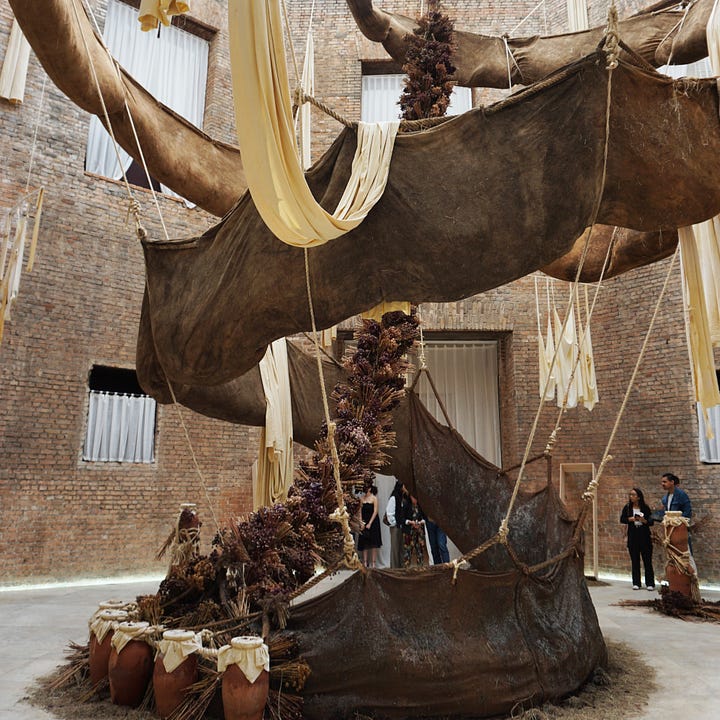
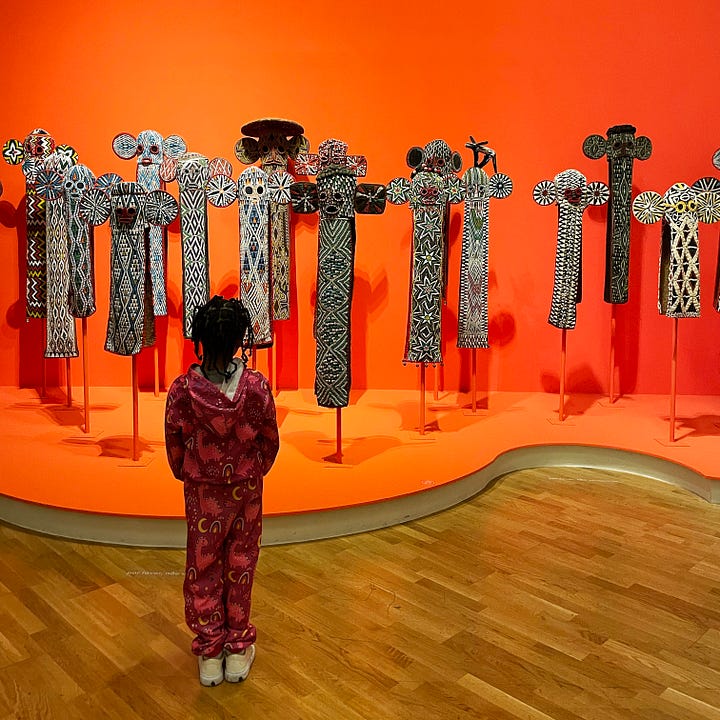
Cidade Matarazzo’s Casa Bradesco—a newly opened venue within one of the former hospital buildings—was worth visiting more for the restoration and the very well-stocked bookshop in the foyer, and less for the slightly underwhelming Anish Kapoor solo exhibition that was on while I was there. The structure was intentionally only partially renovated, allowing the original materials and time-worn surfaces to present its history both inside and out. Landing the Kapoor exhibit was undoubtedly a coup for the curatorial team, but I hope future offerings are more experimental. (Tomás Saraceno was touring the building with us, which may offer a clue…).
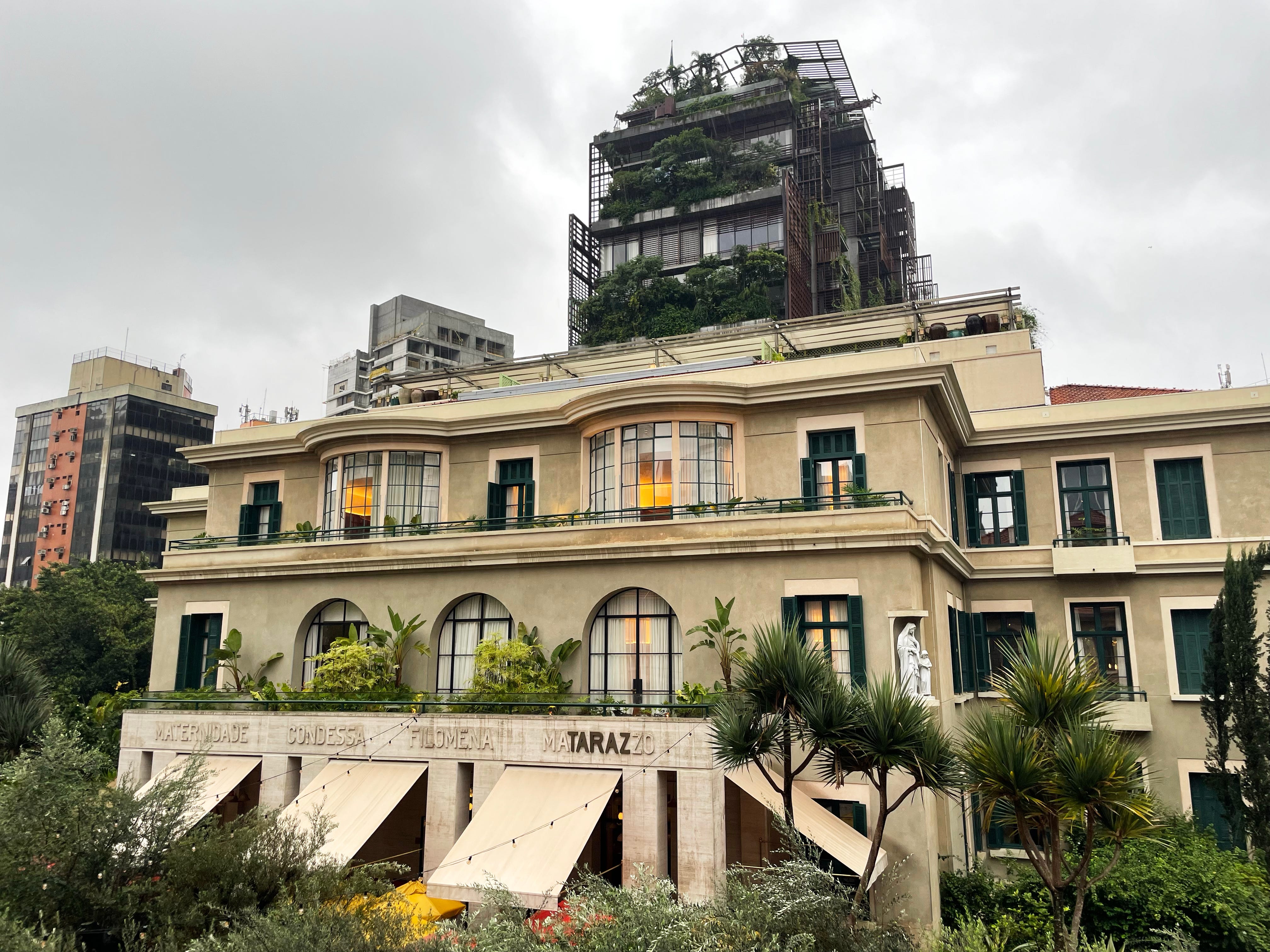
Rosewood São Paulo
“The Best Hotel in South America” is quite a claim. The Rosewood São Paulo was effectively awarded the title by The World’s 50 Best Hotels, an influential list published by William Reed that’s compiled annually by a jury of travel industry experts. Rosewood São Paulo (RSP) took the 24th spot in the 2024 edition, the highest of any on the South American continent. (For context, Reschio from Issue 003 ranked 42nd.) So my self-appointed task during my three-night stay was to discern if it has earned this accolade. I obviously haven’t been to every hotel in South America to accurately compare, but having reviewed hotels for over a decade, I have a fairly good idea of what makes for an exceptional guest experience.
RSP is conveniently located just off Avenida Paulista, just behind MASP, in the city’s central Bela Vista neighborhood. As mentioned briefly earlier, it’s part of a historic hospital complex first founded in the early 20th century by Count Francesco Matarazzo, a very wealthy industrialist who emigrated from Italy and became one of Brazil’s richest men via the coffee trade. He built the hospital in 1904 as a gift to São Paulo, and added to the site several times with neoclassical buildings by architects Luigi Pucci and Giulio Mecheli—including a maternity ward he named after his wife, Filomena, in 1943. The complex was given heritage status in 1986, but decommissioned not long after, and the abandoned buildings quickly fell into disrepair.
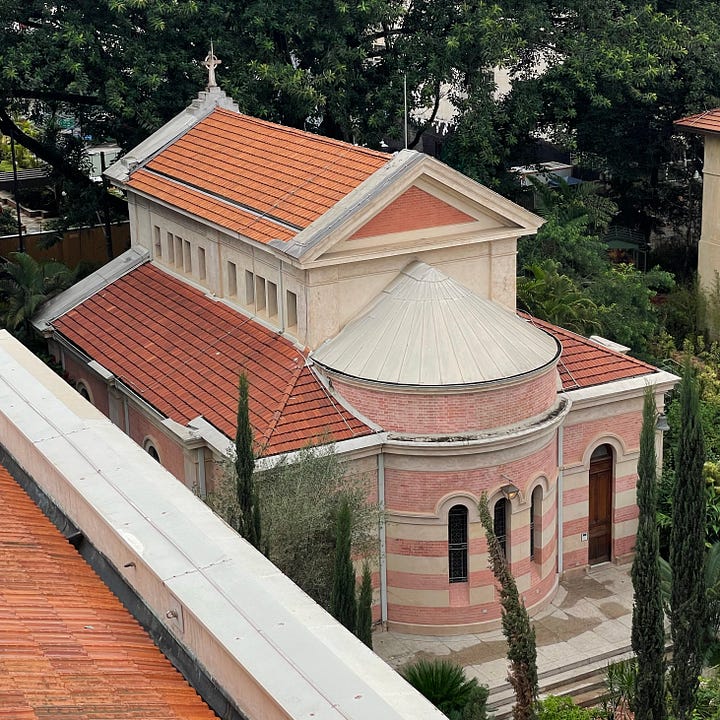
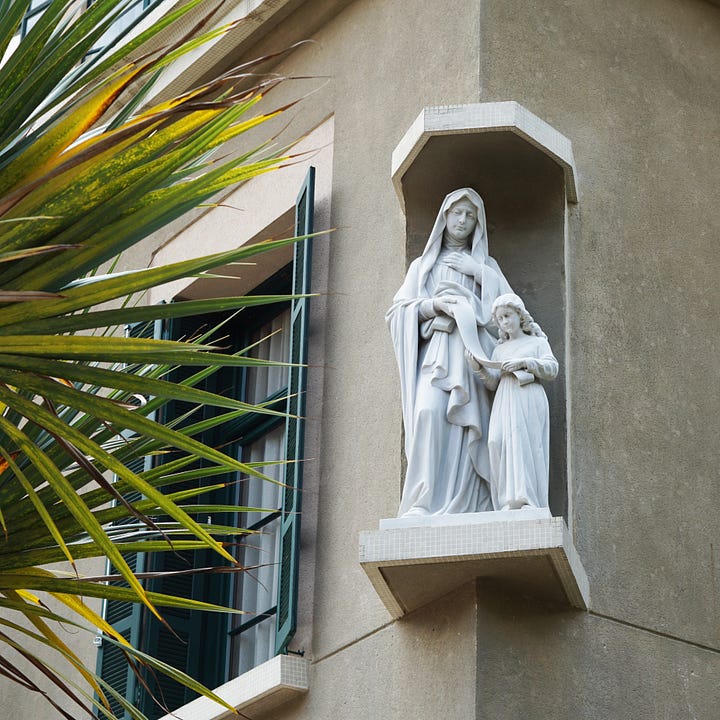
Along came French entrepreneur Alex Allard, who saw the vast potential of the site and acquired it in 2011, with the intention to transform the derelict structures into an arts, leisure, and entertainment hub for São Paulo. Some fairly spectacular structural gymnastics were required to insert parking and underground facilities beneath the listed buildings, and at the northern end of the complex, brand new constructions were added. One of these, the Mata Atlantica tower (which we’ll get into in a moment), forms part of the RSP hotel together with the former maternity building, where millions of Paulistanos can claim to have been born.
Operated by the Rosewood group as one of 33 of its luxury properties around the world, RSP includes 160 guest rooms and suites, as well as 100 fully serviced, Rosewood-branded private residences—part of a growing trend in the high-end hospitality world, as I reported for Galerie. Allard’s French connections are evident throughout the hotel, and the entangling of French and Brazilian cultures adds an intriguing twist to the property.
Architecture & Design
Two heavy-hitting names, both Frenchmen, were responsible for the hotel’s design: Pritzker Prize-winning architect Jean Nouvel, and celebrated designer Philippe Starck. As noted in my article for Dezeen, the new building by Nouvel—his first ever in Brazil—is a lattice-covered concrete tower that, due to its siting at one of the highest points in the city, commands a stellar view across the metropolis from the upper floors.
Accommodating guest suites and private residences, the Mata Atlantica tower has multiple terraces that are planted with local flora, which will eventually cover the latticework and turn the skyscraper into a vertical jungle. This sits in contrast to the Italianate maternity hospital building, which has been preserved and rejuvenated on the exterior, but entirely overhauled inside.
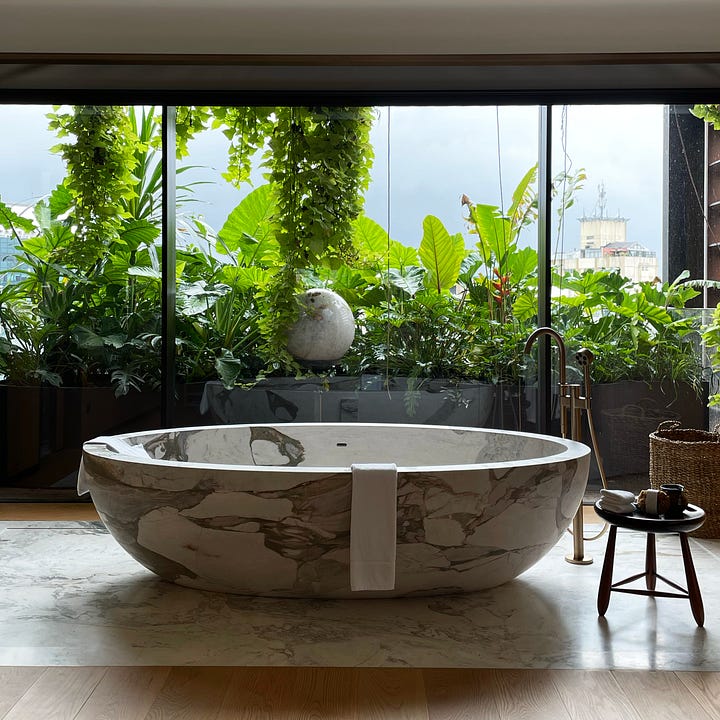
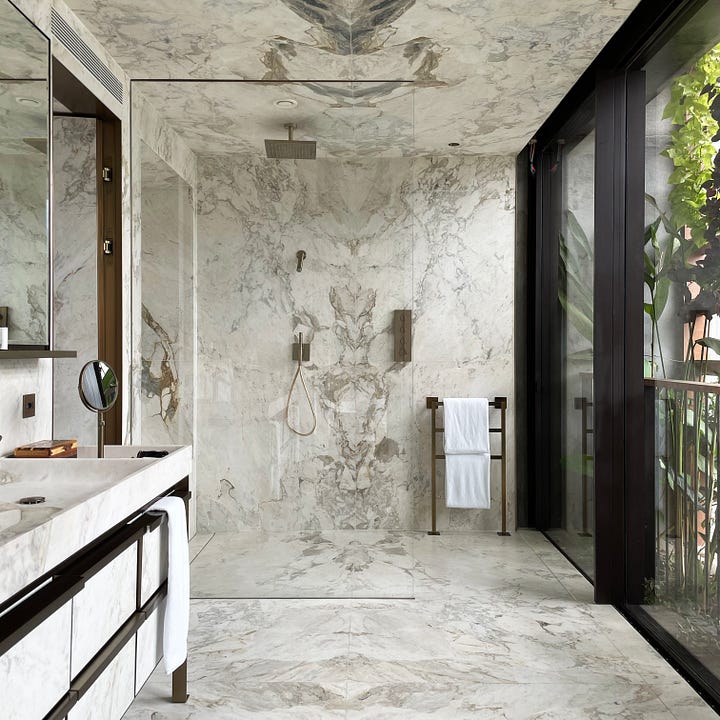
For the interiors, Starck made it his mission to solely source Brazilian materials and furniture, and use only local suppliers and artisans, resulting in spaces that feel rich, warm, contemporary, and contextual. Particularly impactful are the variety of colorful and richly veined marbles sourced from the nearby state of Paraná, which line the bathrooms in all of the guest rooms and the public areas—and are also carved into ovoid freestanding tubs in the larger suites.
Copious amounts of dark glossy-finished ipe wood, mirrors, mid-century furnishings, and decorative musical instruments are found throughout the earth-toned interiors, while other recurring motifs include diamond-shaped paneling, and beautifully illustrated wallpaper by Brazilian artist Virgílio Neto—whose designs can also be found on custom accessories like umbrellas.
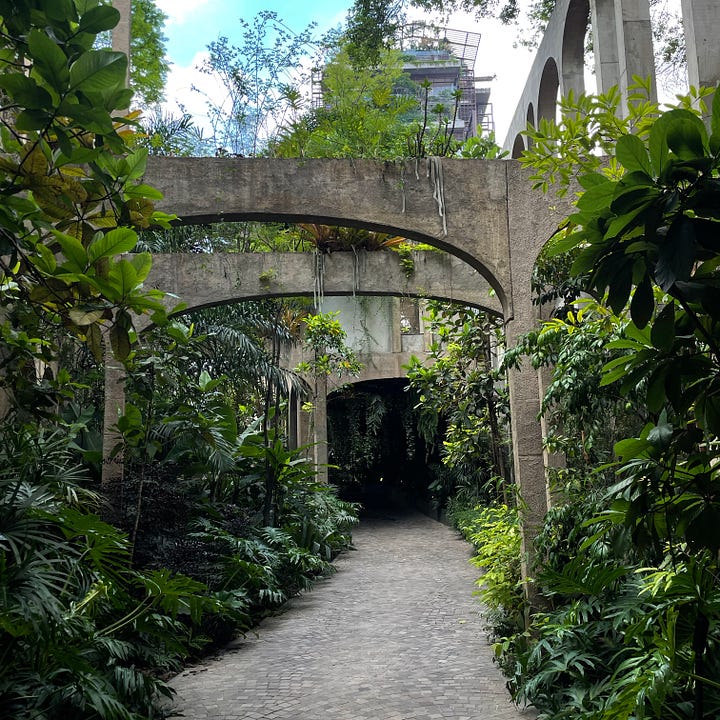
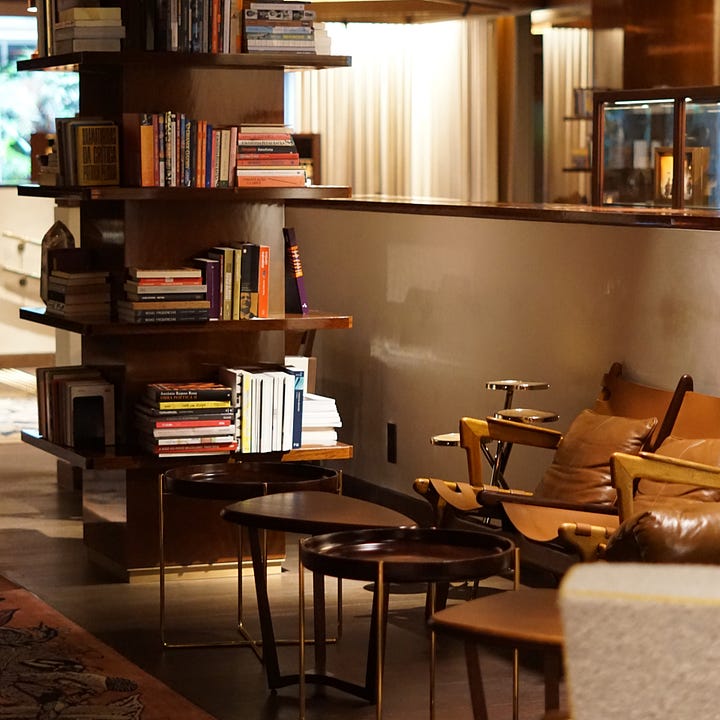
Arrival & Lobby
Talk about making an entrance! Driving in under a plant-covered concrete canopy and along an undulating ramp, a sharp turn leads into a porte cochere. Mirrors entirely cover one side, while the hotel lobby’s seating and bookshelves spill out past the glass facade and onto the driveway on the other. SUVs and limousines with tinted windows pull up one after the other to drop-off elegantly dressed guests, visitors, and others arriving for dinners, weddings, art openings, and whatever else may bring them there.
This hotel is evidently the place to be in São Paulo, and the lobby was buzzing day and night. Set over two half-levels, the space does not have nearly enough seating for the amount of people constantly milling around, and therefore feels perpetually crowded. Perhaps that’s the vibe they’re going for? It’s therefore not surprising that the full-time residents have their own private entrance into the tower, which is much more calm and secluded.
Guest Rooms
I stayed in a Standard Tower Room on a lower floor of the Jean Nouvel building. Although it overlooked a construction site across the street, the room itself was very pleasantly decorated and felt comfortable the moment I walked in. The decor was neither minimally neutral nor overtly expressive (it’s usually one or the other these days), but it could’ve done with a little more personality. For a standard room, it was plenty spacious and had a separate closet area, a loveseat and table at the end of the bed, and a large balcony (which I didn’t really use due to the persistent construction noise). The bathroom was enormous (maybe gratuitously so) and could be opened to the sleeping area via sliding mirrored panels, while the high-tech toilet was tucked away in a separate room—which even during a single-occupancy stay, I appreciate.
Every time I returned to the room, there was a new treat waiting for me! Sweet local snacks, sandals from Brazilian brand Melissa, a full toiletry set, a framed picture of myself(?!)… Lovely touches, though tricky when you already overpacked your carry-on.
During my stay I was offered a peek at a Signature Suite, which is a major jump in square footage from my room. A double-height lounge, a large kitchen and dining area, an office space, and multiple bedrooms over two levels—all with the same earth tones and material selections as the standard room—makes for a very comfortable setup that would particularly work well for a large group staying for an extended period.
Our group was also given a tour of the Penthouse Residence, a truly impressive multi-story bolthole at the tippy top of the tower. Its residents were still sleeping(!) while we poked around, so we tippy toed through the 12,000 square feet of space. The vast double-height living area is filled with collectible furniture pieces and spots to enjoy the incredible panoramic view across the city from every angle. The (unoccupied) bedrooms and smaller lounge areas were less impressive, but the real show-stopper was the rooftop. A full Jurassic Park-like jungle sits on top of the building, through which narrow pathways between the giant plants cut through to seating areas, a hot tub, and finally an infinity pool lined with the most stunning turquoise and rust-veined stone.
Dining & Drinking
RSP has no less than six food and beverage locations on site. The largest is Le Jardin, accessible directly from the lobby and spilling out onto a spacious, covered outdoor patio facing lush landscaping. Bright and open during the day then sexy and moody at night, the cafe and restaurant operates 24/7 and serves breakfast round-the-clock, while lunch and dinner options are time-sensitive. The açai bowl was my morning go-to, and the pizzas were great for a lunchtime snack.
Taraz, on the level above, takes its name from “Matarazzo” and has a menu stacked with traditional South American tapas-style dishes—all of which were delicious (and we tried a lot). The menu book is cleverly designed to resemble a passport, and the interiors have a casual rustic charm that still feels elevated. The restaurant continues onto a brickwork terrace directly above the hotel’s porte cochere, where rows of centuries-old olive trees sourced from Uruguay are planted. This would’ve been perfect for dining al fresco, had the weather allowed.
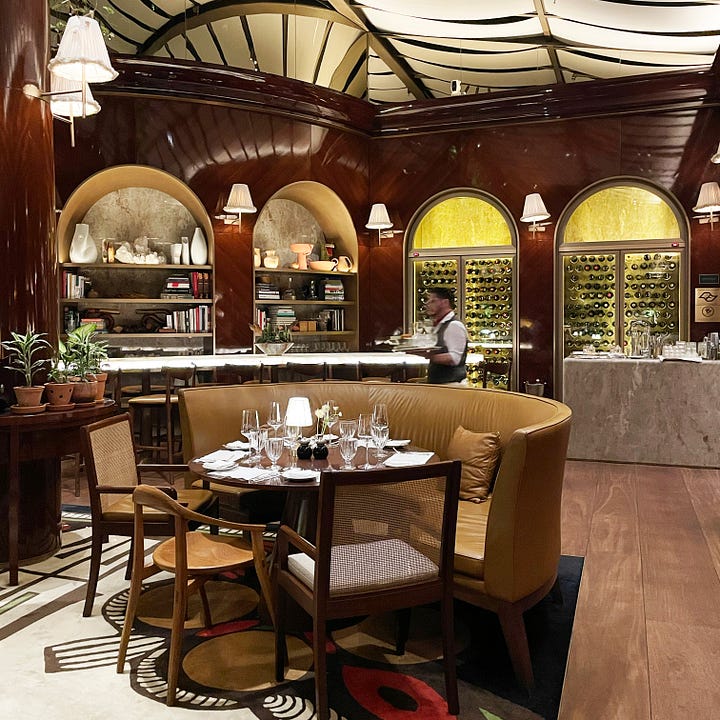
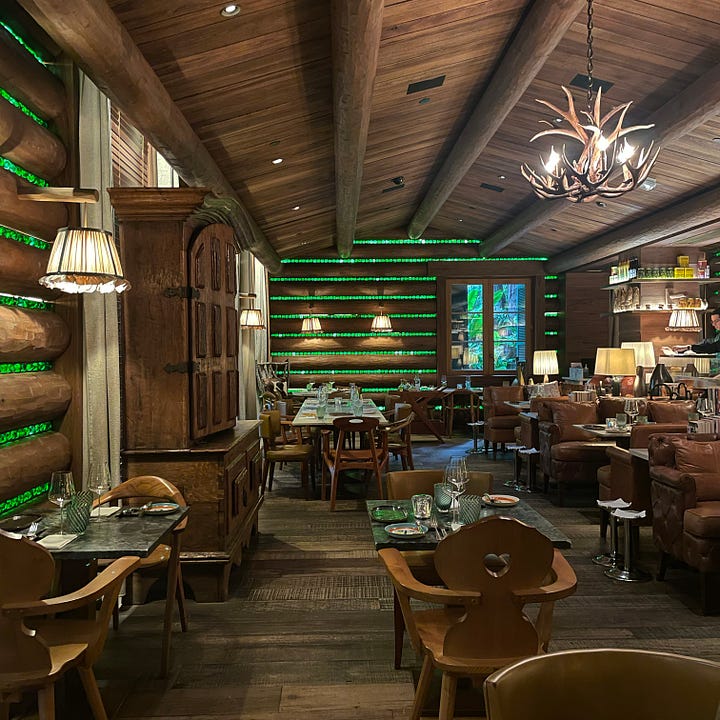
Then there’s Blaise, a brasserie just off Le Jardin that’s influenced by French-Swiss novelist Blaise Cendrars and therefore looks like an Alpine chalet inside. Endearingly, all the tables are set on the left because he lost his right arm in the first world war. Bands of polished green glass stones are embedded between the logs across the walls, while tiles around the open kitchen each portray a female figure sitting in the birthing position (although with their tessellation, it takes a minute to realize this) as a nod to the maternity ward. Of the 8,000 tiles he produced, ceramic artist Fernando de La Rocque also created 40-50 that depict trans women in the same pose. Points for anyone who spots one!
On the other side of Le Jardin, the dark speakeasy-style Rabo di Galo bar is hidden behind a thick curtain and has a celestial fresco by artist Cabelo painted across its vaulted ceiling. The space hosts live-music performances for guests sipping martinis, mocktails, or caipirinhas (a must if you’re in Brazil!).
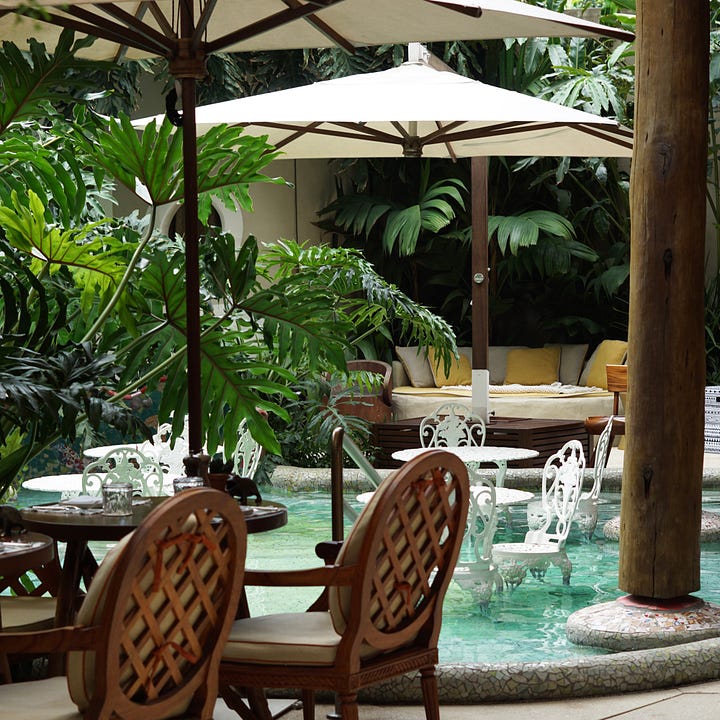
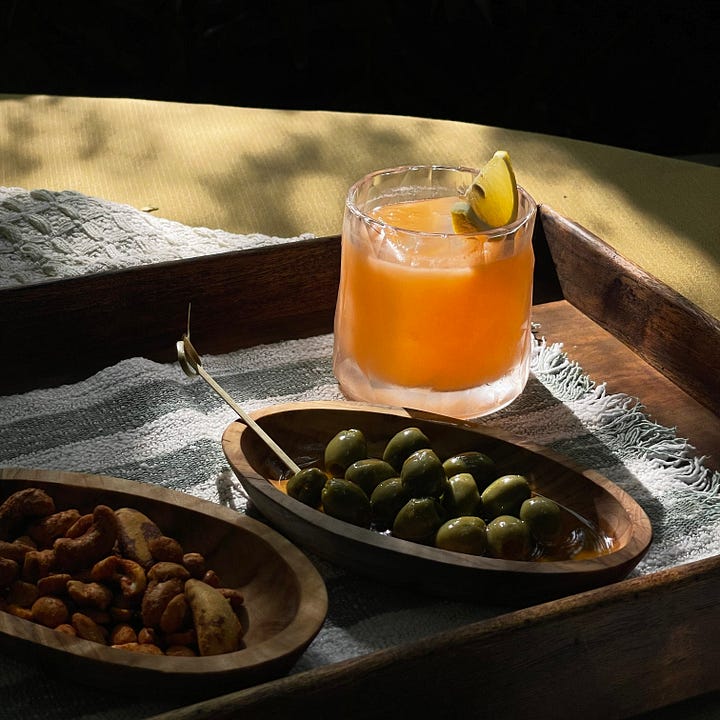
The Emerald Bar is the hotel’s casual poolside offering. This semi-outdoor space at lobby level, positioned between the maternity building and the tower, has a bar made from sustainably sourced wood installed beneath a thatched roof. There are a variety of seating options, from cafe tables to loungers, and even some white cast-iron tables and chairs placed in the shallow water—a rather questionable stylistic choice. Both the food (kebabs, ceviche, dips etc.) and the cocktails here are top-notch.
Last but not least, on the top floor of the maternity building is the Belavista bar, designed to resemble the home of Count Matarazzo’s imaginary aunt, with floral-patterned sofas, caned furniture, and more wallpaper by Neto. The bar also serves a rooftop area on the level above, accessed via a spiraling staircase, which I didn’t get a chance to use.
Amenities
Since this is an urban hotel ultimately geared towards business travelers, there aren’t very many places to relax and lay out in the sun. There is a swimming pool next to the Emerald Bar, which has a fun Gaudí-meets-Niemeyer appearance, where a few outdoor loungers and several private cabana rooms are positioned around its curvy edges. Dense foliage around the pool, although beautiful, does block much of the sun. An alternative is the roof terrace on top of the maternity building, which is decorated with tiles hand-painted in green patterns by local artist Sandra Cinto and surrounded by matching trellis, but again it only has a handful of seats alongside a very small pool. If you want a tan, go to Rio, I guess.
The Araya Spa, on a lower floor of the tower, is run in partnership with French skincare brand Guerlain and offers a wide variety of treatments, as well as private rooms that can be booked for groups or parties. Before my massage, I was given a pure cacao drink that was intended to slow my heart rate and relax my muscles, but it tasted so bad I could only finish half of it. And alas, my masseuse was not a sexy muscular Brazilian man as I had been hoping for. But the woman I did get could easily have been plucked straight out of a high-end beauty ad (as she may well have been) and she was very good.
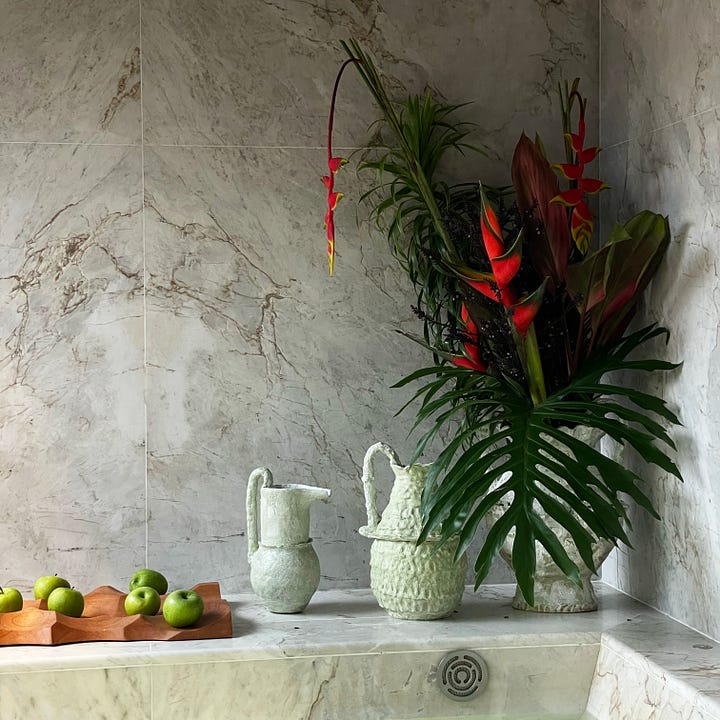
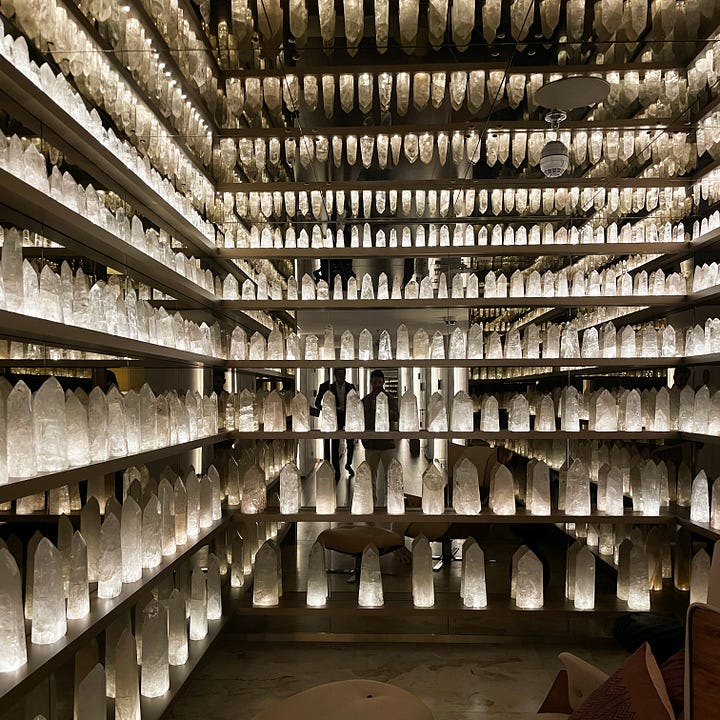
I also had a reflexology treatment in the Crystal Room, a first for me since I don’t particularly like having my feet touched (I’m very ticklish). But the therapist was gentle and it was relaxing, though I’m not sure the floor-to-ceiling displays of crystals did anything other than look pretty. The fitness suite on the same level is one of the better hotel gyms I’ve used, and is very well equipped for both cardio and weight workouts. Extra snaps there.
RSP has no shortage of space for events, including a gigantic ballroom that has so far hosted everything from Formula 1 parties to cattle markets (no joke!). When the cows have left, it’s also an ideal venue for large weddings, and there’s even a chapel for services on site—originally built in 1922 and dedicated to Santa Luzia at the request of Count Matarazzo’s sister-in-law Virginia, after her son's eye-related illness was cured. The restoration of the chapel, which is typically open to the public, included the installation of a stained-glass rosette window by internationally acclaimed Brazilian artist Vik Muniz—one of a multitude of commissions from local talents for the hotel, which we’re about to get into.
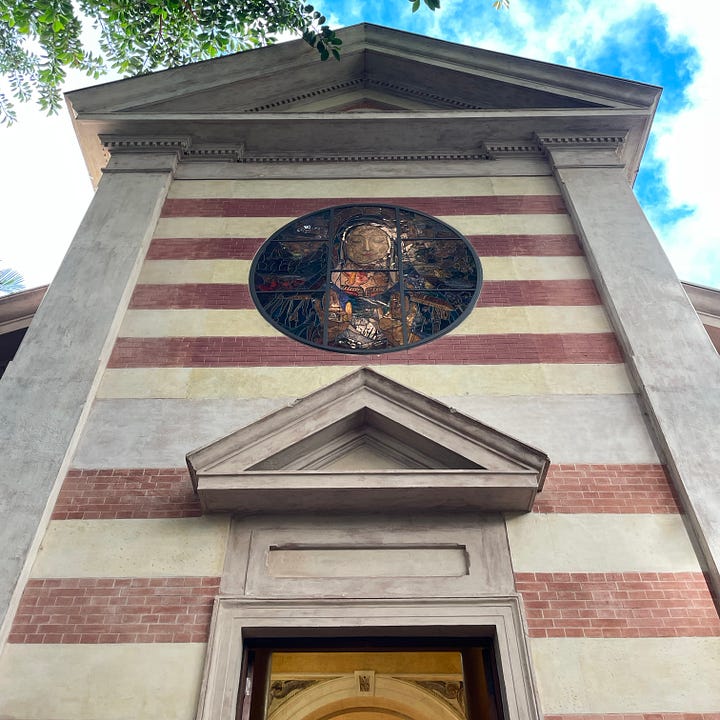
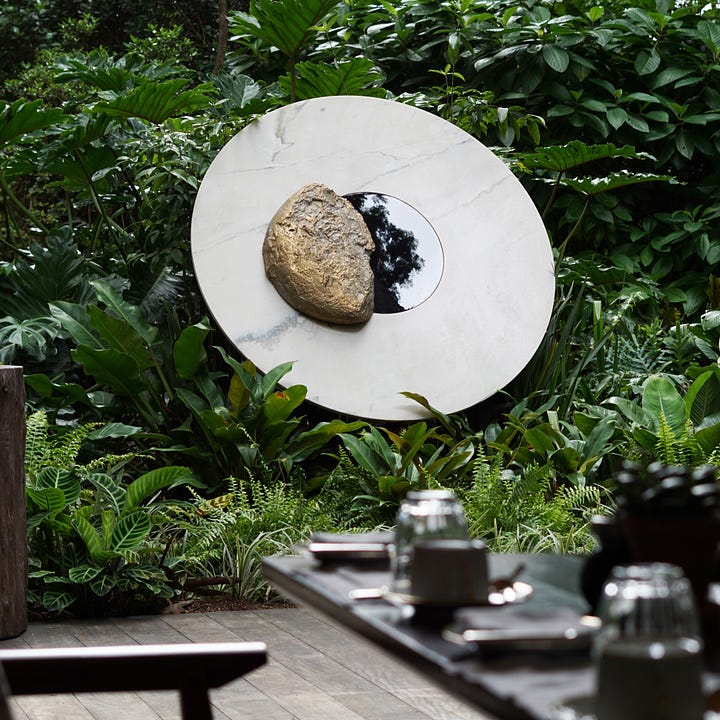
Arts Program
One of the most notable and impressive elements of the hotel is a commitment to spotlighting Brazilian artists. It houses over 450 site-specific works created by 57 creatives from all over Brazil: from established names like Regina Silveira, whose insect-patterned carpets run through the lobby and ground-floor hallways; to emerging talents such as Walmor Corrêa, who’s behind the beautiful botanical-inspired illustrations with a fantastical twist that line each elevator.
Along with the other commissioned pieces I’ve mentioned earlier, a couple more standouts include Laura Vinci’s floating golden leaves and branches suspended in the maternity building’s fifth-floor corridor, and a collection of photos by Cristiano Mascaro that eerily depict the building pre-renovation and are displayed throughout the hotel. Plus so many more that I didn’t note down correctly. There’s also a residency program, revolving exhibitions in the hallways, and an evident continued interest in supporting local arts.
Overall, the focus on “local” is the hotel’s greatest achievement. Both the renovated historic building and the contemporary tower are cleverly tied together through the use of these custom artworks and Brazilian materials, plus the native flora that creates lush environments around and over the two structures. Not to mention all of the subtle, multifarious nods to the site’s past, which strike a progressive and forward-looking tone, and the blending of French and Brazilian cultures in a way that doesn’t insist upon itself or feel too contrived. Together with the state-of-the-art facilities, diverse culinary offerings, and plenty of chic touches, the team has been able to create a “see-and-be-seen” spot for São Paulo without really trying that hard. If you build it, they will come, as is said.
It’s all of this—but particularly the art curation, IMO—that collectively sets RSP above so many others and likely landed the hotel its rightful spot on The World’s 50 Best list. As for all the other hotels in South America, I’m more than happy to come and experience any challengers to the title, and offer my two cents in a future issue of this newsletter. (Please email me if you’re interested in making this happen!) And if the U.S. becomes unbearable over the next four years, Brazil is definitely a solid relocation option…
Thank Yous
Firstly, thanks to Chase Pardue at Purple PR for suggesting and setting up this trip. A huge and heartfelt thank you to Juliette Granon for shepherding us so dutifully, accommodating our every whim and desire, and generally being such a trooper. Our other (official) tour guides, André Vecchi and Lucio Gueller, thank you for sharing your knowledge and expertise so enthusiastically. To my trip-mates, Rachel King, Dalya Benor, and Arthur Lubow, thanks so much for your candor and conversation, it was a great time with you all. Katiane Romero at Soho House São Paulo, thank you so much for lunch! And from the Rosewood team, special thanks to Monica Cipolla for allowing us a sneak peak at the penthouse (despite its occupants being asleep in some of the bedrooms), Silvio Araújo for ordering everything on the menu wherever we dined, and Edouard Grosmangin for hosting us so graciously (and for the umbrellas!). D x



